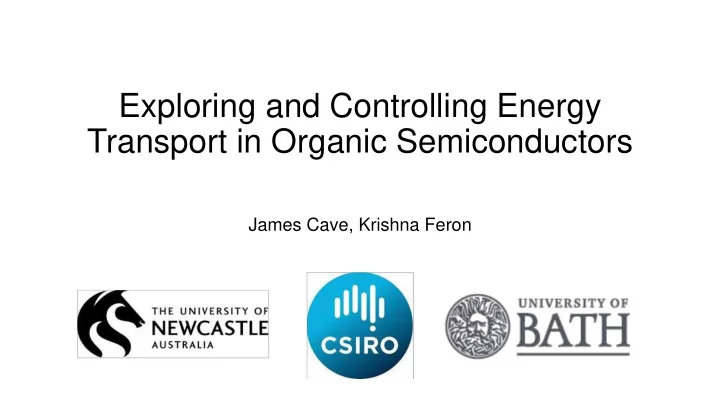

Exploring and Controlling Energy Transport in Organic Semiconductors James Cave, Krishna Feron
Excitons • Organic materials have small permittivity ε r • Coulomb interaction strong, electron-hole binding energy large, >k B T • Charge carriers do not readily separate • Electron-hole pair moves together as electrically-neutral quasiparticle that carries energy: the exciton • Exciton must dissociate into e - and h + at an interface between materials • Exciton readily recombines on short timescale (~ns)
Förster Resonance Energy Transfer (FRET) • Exciton acts as oscillating dipole • Dipole-dipole coupling between exciton and electron in ground state allows energy transfer via near-field radiationless mechanism 6 1 𝑆 0 • 𝑙 𝐺𝑆𝐹𝑈 = τ 𝑠 • Exciton instantly hops
6 𝑙 𝐺𝑆𝐹𝑈 = 1 𝑆 0 Förster Radius R 0 τ 𝑠 • R 0 is characteristic distance where FRET efficiency 𝑙 𝐺𝑆𝐹𝑈 1 1 𝐹 𝐺𝑆𝐹𝑈 = 𝑙 𝐺𝑆𝐹𝑈 +𝑙 𝑠𝑓𝑑𝑝𝑛𝑐 = 2 where 𝑙 𝑠𝑓𝑑𝑝𝑛𝑐 = τ From theory: 6 = 9000 𝑅 0 (ln 10)κ 2 𝑆 0 𝐾 128 𝜌 5 𝑜 4 𝑂 𝐵
FRET and Dissociation
Kinetic Monte Carlo (KMC) • Stochastic method for simulation evolution of system over time (built-in clock) • Allows tracking of trajectories of individual entities • We use First Reaction Method (FRM)
System • Cubic lattice, spacing 1 nm • Each site is a certain material (e.g. P3HT) • Excitons exist on sites • Site occupancy limited to 1 • Where site is adjacent to another site of a different material, it is an interface site
Events 1 Δ𝐹 ≤ 0 6 1 𝑆 0 • Hop via FRET: 𝑙 𝐺𝑆𝐹𝑈 = × Δ𝐹 exp − Δ𝐹 > 0 𝜐 𝑠 𝑙 𝐶 𝑈 1 • Recombination: 𝑙 𝑠𝑓𝑑𝑝𝑛𝑐 = 𝜐 • Generation: 𝑙 𝑓𝑜 = 10 s -1 per lattice site (equivalent to AM1.5)
Dissociation • Treated differently to other events • When executed event places an exciton at a boundary site, probability p that the exciton instantly dissociates, otherwise no effect
KMC Queue • Queue is chronologically ordered list of events • Events are executed in order • When event occurs, newly enabled events added to queue 1 • Time until event i occurs 𝑢 𝑗 = − 𝑙 𝑗 ln(𝑣) where u in range (0, 1] • This draws times from exponential distribution • For mutually exclusive events, e.g. hopping, only shortest time need be inserted into queue
KMC Method • Remove invalid events from start of queue • Execute first (valid) event, i • Reduce times for all other events by t i • Add newly enabled events • Repeat
Material Values σ ( eV) Materials Q 0 (%) L (nm) Exciton lifetime (ns) P3HT 25 15 [2] 0.9 [5] 0.06 8.3 x 10 -2 [1] PCBM 9 [3] 1.4 [1] 0.09 DIBSq - 3 [4] 4.9 [5] 0.05 Unreferenced values have been determined from our experimental work [1] Wang, H., He, Y., Li, Y. & Su, H. Photophysical and electronic properties of five PCBM-like C 60 derivatives: Spectral and quantum chemical view. J. Phys. Chem. A 116, 255 – 262 (2012). [2] Shaw, P. E., Ruseckas, A. & Samuel, I. D. W. Exciton Diffusion Measurements in Poly(3-hexylthiophene). Adv. Mater. 20, 3516 – 3520 (2008). [3] Cook, S., Furube, A., Katoh, R. & Han, L. Estimate of singlet diffusion lengths in PCBM films by time-resolved emission studies. Chem. Phys. Lett. 478, 33 – 36 (2009). [4] Wei, G. et al. Functionalized squaraine donors for nanocrystalline organic photovoltaics. ACS Nano 6, 972 – 978 (2012). [5] An, Q. et al. Improved Efficiency of Bulk Heterojunction Polymer Solar Cells by Doping Low Bandgap Small Molecule. ACS Appl. Mater. Interfaces (2014).
Förster Radii Energy acceptor R 0 (nm) P3HT PCBM DIBSq P3HT 2.3 2.7 5.0 Energy PCBM - 2.3 1.2 donor DIBSq - - 1.1 • Heterotransfer R 0 was calculated based on absorption and fluorescence measurements • Homotransfer R 0 was calculated based on exciton diffusion length and energy disorder
Absorption and Fluorescence Spectra
Energy Levels
FRET and Dissociation in Binary BHJs • Most KMC models ignore heterotransfer • We study fraction of dissociated excitons that underwent heterotransfer
FRET and Dissociation in Binary BHJs • We also vary p for each side of the interface and observe the effect on the exciton dissociation efficiency η
Binary BHJ Morphologies Random F = 15 nm F = 31 nm Feature size F = 3 V / A
η in P3HT:PCBM BHJ With Heterotransfer Without Heterotransfer
Difference (Without minus With)
Dissociated Excitons That Undergo 2 Step Dissociation in P3HT:PCBM BHJ Experimental evidence: Lloyd et al. (2008) Hole transfer very fast, electron transfer is slower
η in Ternary BHJs • Can also make ternary BHJ structures • We use DIBSq as our third material • Random interface sites replaced with DIBSq
Exciton dissociation efficiency vs DIBSq concentration for various feature sizes (P3HT) 100 • FRET helps with exciton dissociation, allowing for 95 larger feature size, which is 90 better for charge extraction 85 • Dissociation efficiency η as 80 function of DIBSq 75 concentration 70 65 F = 14, 15, 31 nm 60 0 1 2 3 4 5 6 Dissoc. Eff. (%) Small Dissoc. Eff. (%) Large Dissoc. Eff. (%) Double
Exciton dissociation efficiency vs DIBSq concentration for various feature sizes (P3HT) 90 • FRET helps with exciton 80 dissociation, allowing for 70 larger feature size, which is better for charge extraction 60 50 • Fraction of excitons that 40 dissociate at a DIBSq 30 interface 20 10 F = 14, 15, 31 nm 0 0 1 2 3 4 5 6 Sq dissoc./total dissoc. (%) Small Sq dissoc./total dissoc. (%) Large Sq dissoc./total dissoc. (%) Double
Acknowledgements • Alison Walker • Paul Dastoor
Recommend
More recommend